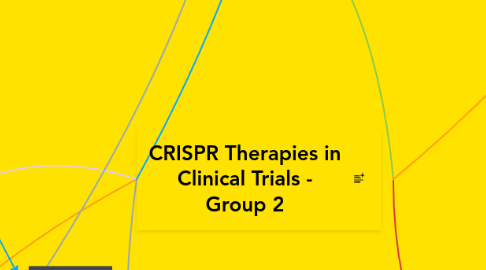
1. Development
1.1. Potential diseased state to treat
1.1.1. Cancer
1.1.1.1. Cut
1.1.1.1.1. Cut genes that limit cancer killing effect
1.1.1.1.2. Cut interfering genes
1.1.1.2. Screening
1.1.1.2.1. Direct vivo
1.1.1.2.2. Indirect vivo
1.1.1.3. Vitro
1.1.1.3.1. Clone the sgRNA of chioce
1.1.2. Hereditary blindness
1.1.2.1. 1/2000 people worldwide
1.1.2.1.1. IRD (Inherited Retinal Degeneration)
1.1.3. AIDS
1.1.3.1. Situation
1.1.3.1.1. We have drugs to decrease viral replication
1.1.3.2. "Surgical knives"
1.1.3.2.1. Zinc finger nucleases (ZFN)
1.1.3.2.2. Transcription Activator-like Effector Nucleaases (TALENs)
1.1.3.2.3. CRISPR
1.1.4. The future
1.1.4.1. Other probable uses in research
1.1.4.1.1. Sickle cell disease
1.1.4.1.2. Cystic fibrosis
1.1.4.1.3. Huntingdon's disease
2. Clinical Trials Using in vivo & ex vivo delivery of CRISPR
2.1. Ex Vivo Gene Editing
2.1.1. Ex vivo editing = T cells expanded ex vivo and then transfused back into patient
2.1.1.1. 2016 First clinical trial using CRISPR for cancer therapy
2.1.1.1.1. Sichuan University’s West China Hospital in Chengdu in 2016
2.1.1.2. Other successful clinical trials include gene editing for the following conditions
2.1.1.2.1. Bladder Cancer
2.1.1.2.2. B-Cell Lymphoma
2.1.1.2.3. Multiple myeloma
2.1.1.2.4. Esophageal cancer
2.2. In Vivo Gene Editing
2.2.1. CRISPR/Cas9 targeting HPV
2.2.1.1. Less implemented in clinical trials
3. Editing Gene Method
3.1. plasmid-based CRISPR-Cas9 system encoding the Cas9 protein and sgRNA from the same vector
3.1.1. Cas9/sgRNA complex inside cells
3.2. mixture of the Cas9 mRNA and the sgRNA.
3.2.1. Cas9 mRNA will be translated
3.2.1.1. the Cas9/sgRNA complex
3.3. Cas9/sgRNA complex
4. Nuclear localization
5. Active Clinical Trials
5.1. Companies
5.1.1. Original developers have developed their own companies
5.1.1.1. Caribou Biosciences by Charpentier
5.1.1.2. CRISPR Therapeutics by Doudn
5.1.1.3. Editas by Feng Zhang
5.1.2. Leading Biotechnology Companies
5.1.2.1. AstraZeneca,
5.1.2.2. DuPont
5.1.2.3. Novartis
5.1.2.4. Thermo Fisher Scientific
5.1.2.5. Signma Aldrich
6. What is CRSPR?
6.1. If the assigned RNA is found on the bacterium DNA, the DNA will be trimmed off
6.2. "Clustered Regularly Interspaced Short Palindromic Repeats"
6.3. Bateria's Anti-viral system
6.3.1. similar to immunological memory, but at DNA scale
6.3.2. Bacteria copy and store DNA segments inserted by the bacteriophage into CRSPR
6.3.2.1. The segments are transcripted to RNA and assigned to Cas9
7. Cas-9
7.1. Cas9 scouts around for the assigned RNA
7.2. CRSPR-Associated protein 9
8. CRSPR-Cas9 Gene Editing
8.1. Cas9 can find and cut whatever RNA segments it is assigned
8.1.1. CRSPR-cas9 is a high-precision DNA cutting/inserting tool
8.2. DNA repair
8.2.1. NHEJ
8.2.1.1. "Non-Homologous End Joining"
8.2.1.1.1. The body's DNA repair mechanism will automatically join the two ends of the DNA strand previously cut by Cas9
8.2.2. HDR
8.2.2.1. "Homologous Directed Repair"
8.2.2.1.1. Adding a DNA template that the DNA repair mechanism can build on to join the two ends of the DNA strand previously cut by Cas9
9. Delivery
9.1. Viral Vectors
9.1.1. Retrovirus
9.1.2. Adenovirus
9.1.3. Lentivirus
9.1.4. Adeno-associated virus (AAV) vectors
9.2. Non-Viral Vectors
9.2.1. Gold Nanoparticles
9.2.2. Lipid-Mediated Transfection
9.2.3. Cell-Penetrating Peptides
9.2.4. DNA Nanoclews
9.2.5. Liposomes
9.3. Direct Transport
9.3.1. Co-Microinjection
9.3.2. Lance Array Nanoinjection
9.3.3. Electroporation
9.3.4. Hydrodynamic Delivery
10. Side effects
10.1. Genetic Drive
10.1.1. Genetic Damage
10.1.1.1. Complex rearrangements
10.1.1.2. Unexpected large deletions
10.1.1.3. Off-target alterations
